Abstract
The faecal flora of 21 patients with proctocolitis and five patients with Crohn's disease of the large bowel was examined both while sulphasalazine was being administered and during control periods. Patients with proctocolitis and Crohn's disease who were not receiving sulphasalazine had a similar flora which did not differ in any way from the normal. The effect of sulphasalazine was to decrease the numbers of opalescent-negative clostridia, enterobacteria, and total non-sporing anaerobes. It is suggested that this antibacterial effect of sulphasalazine, which has not been previously demonstrated, may be related to the beneficial effects of this drug in proctocolitis and should be investigated further.
Full text
PDF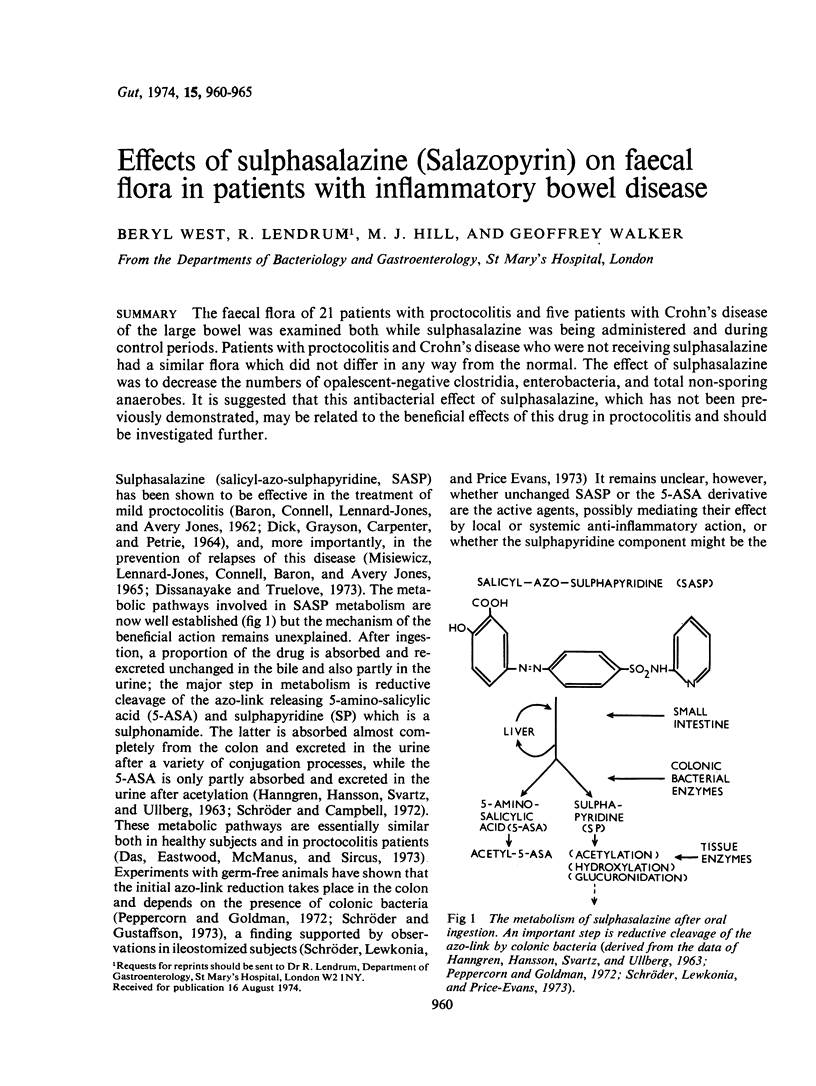
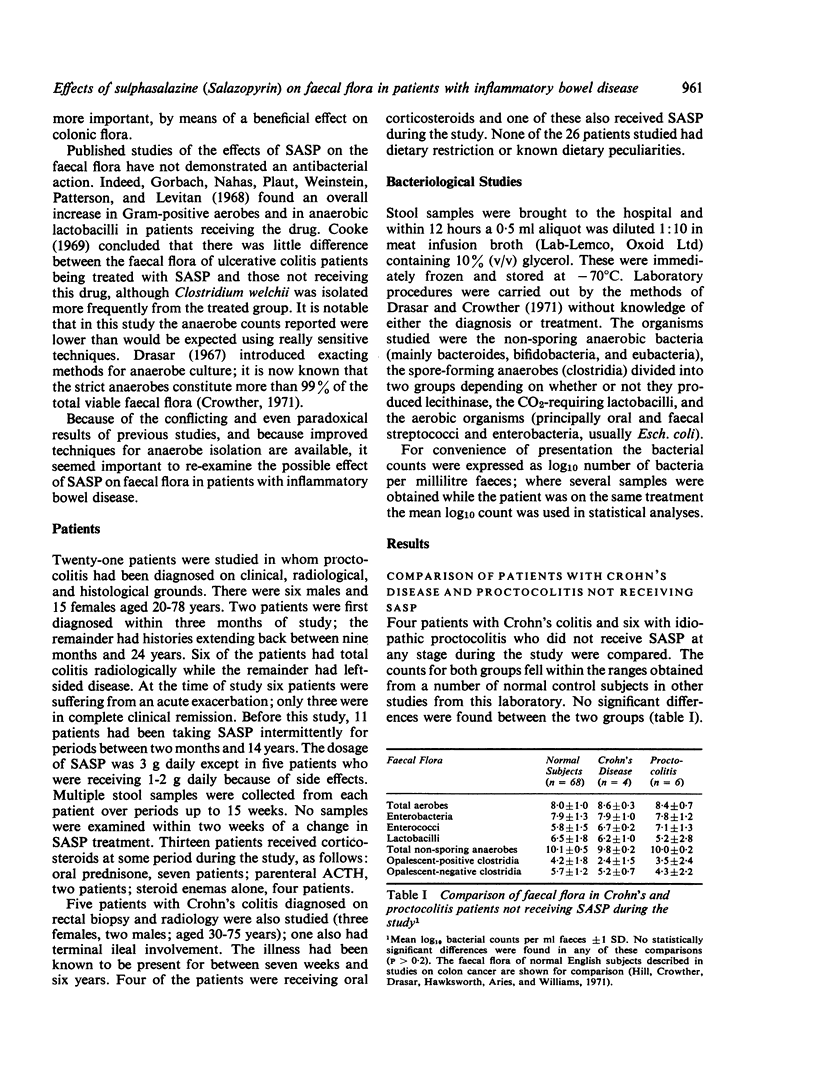
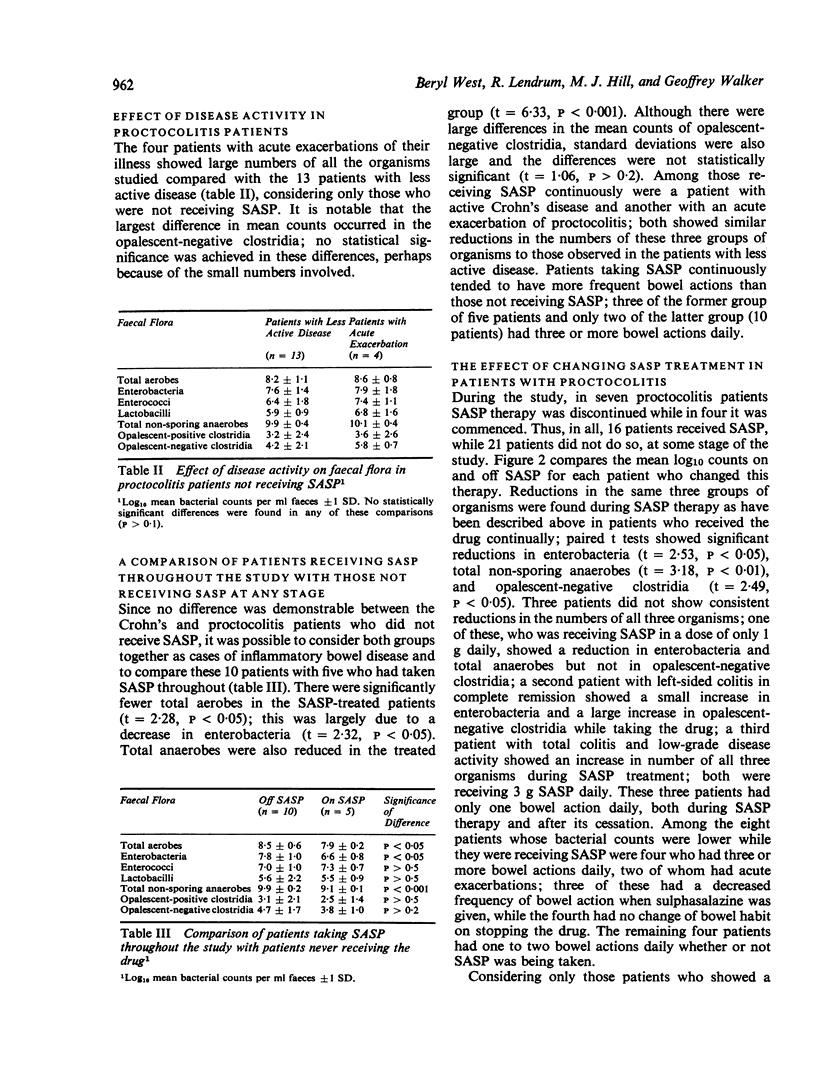
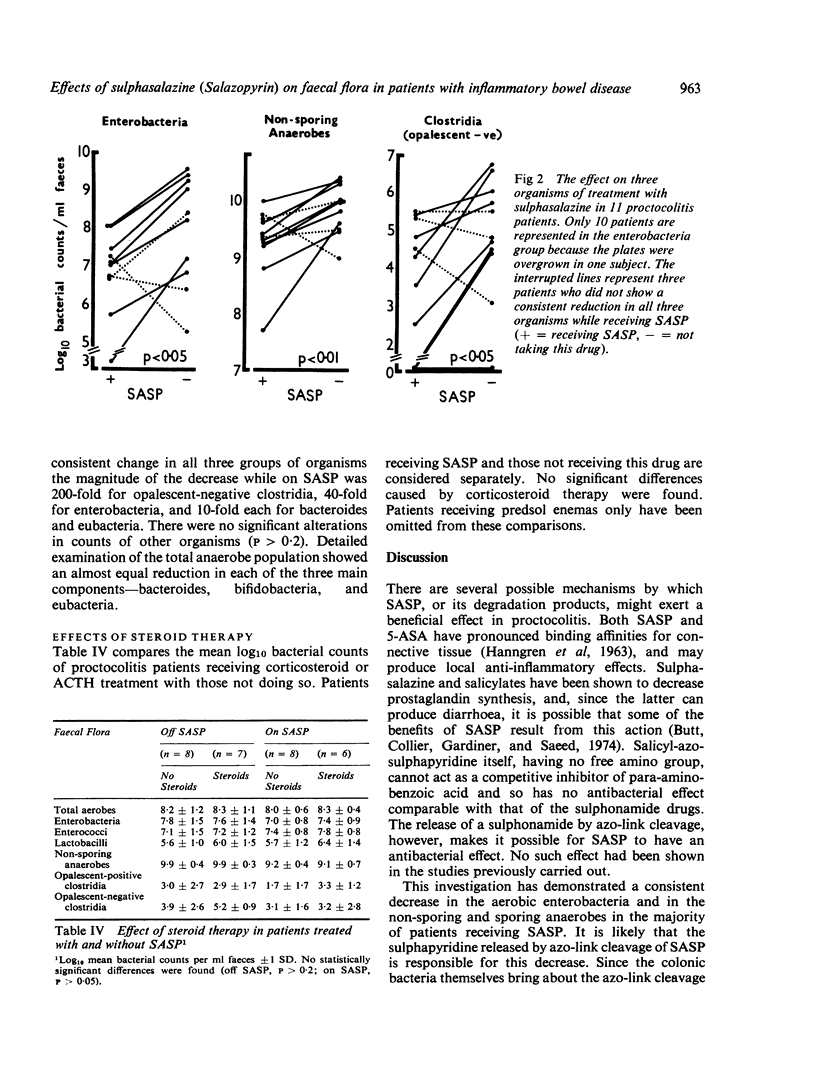
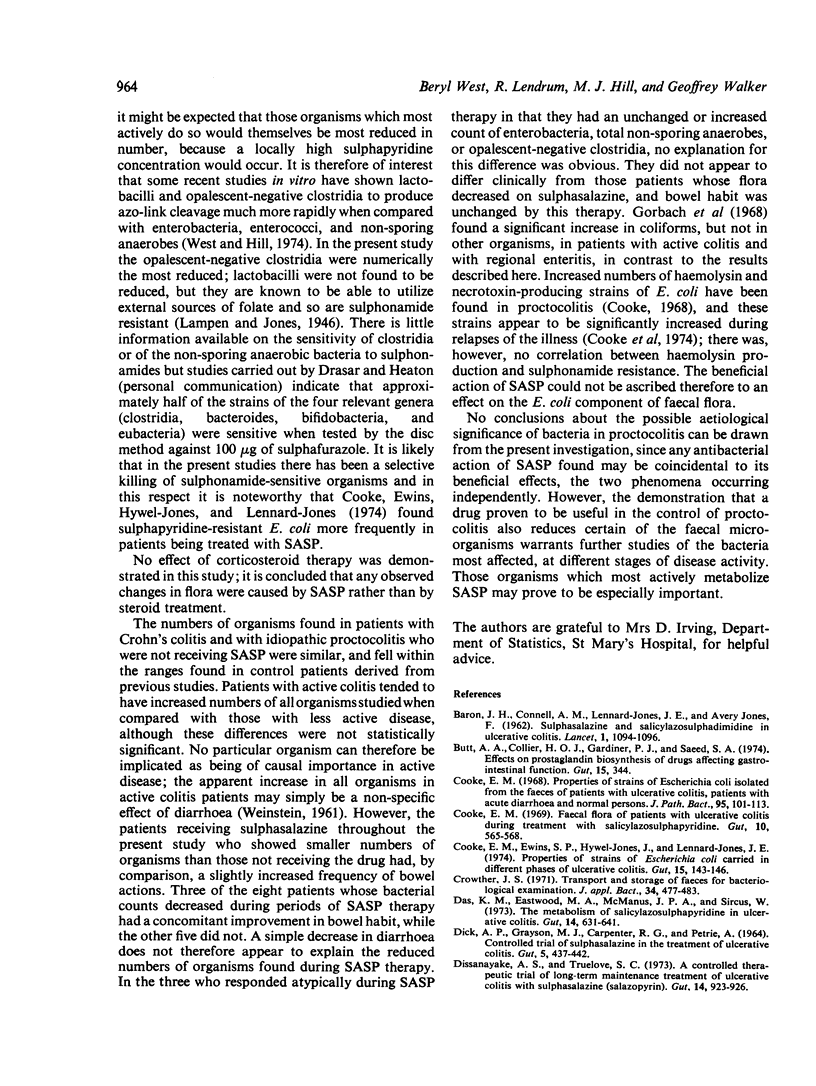
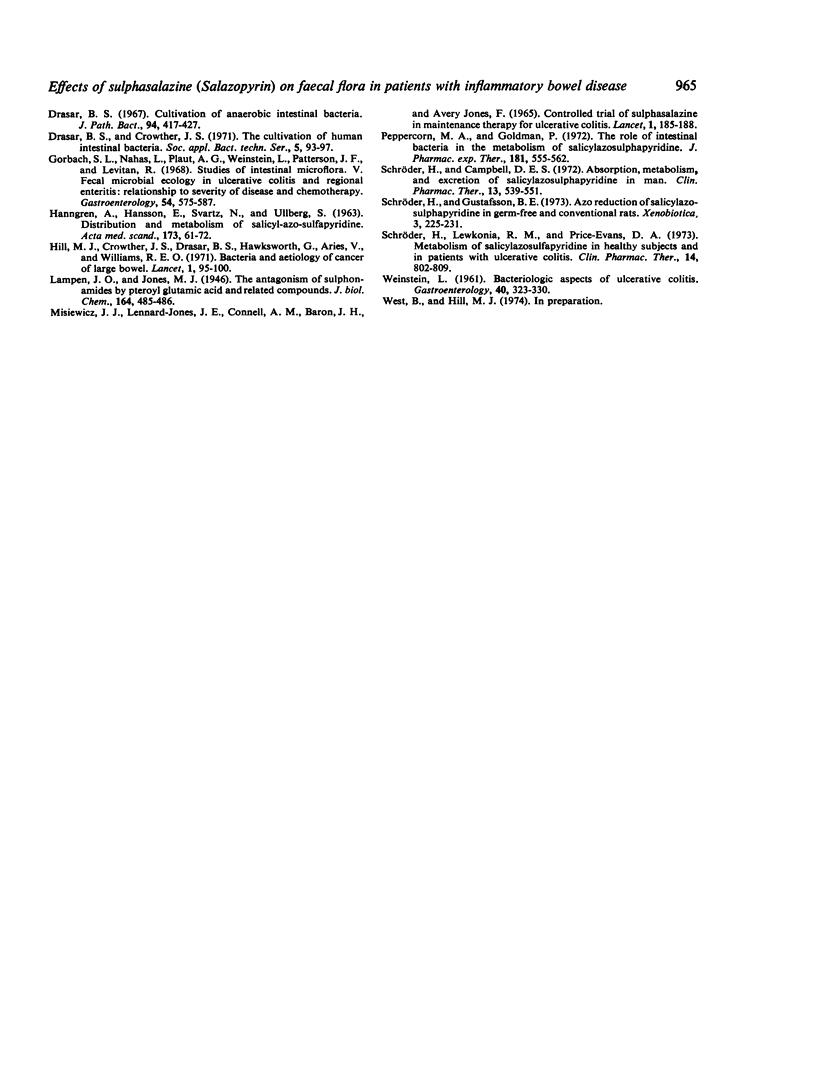
Selected References
These references are in PubMed. This may not be the complete list of references from this article.
- BARON J. H., CONNELL A. M., LENNARD-JONES J. E., JONES F. A. Sulphasalazine and salicylazosulphadimidine in ulcerative colitis. Lancet. 1962 May 26;1(7239):1094–1096. doi: 10.1016/s0140-6736(62)92080-9. [DOI] [PubMed] [Google Scholar]
- Butt A. A., Collier H. O., Gardiner P. J., Saeed S. A. Proceedings: Effects on prostaglandin biosynthesis of drugs affecting gastrointestinal function. Gut. 1974 Apr;15(4):344–344. [PubMed] [Google Scholar]
- Cooke E. M., Ewins S. P., Hywel-Jones J., Lennard-Jones J. E. Properties of strains of Escherichia coli carried in different phases of ulcerative colitis. Gut. 1974 Feb;15(2):143–146. doi: 10.1136/gut.15.2.143. [DOI] [PMC free article] [PubMed] [Google Scholar]
- Cooke E. M. Faecal flora of patients with ulcerative colitis during treatment with salicylazosulphapyridine. Gut. 1969 Jul;10(7):565–568. doi: 10.1136/gut.10.7.565. [DOI] [PMC free article] [PubMed] [Google Scholar]
- Cooke E. M. Properties of strains of Escherichia coli isolated from the faeces of patients with ulcerative colitis, patients with acute diarrhoea and normal persons. J Pathol Bacteriol. 1968 Jan;95(1):101–113. doi: 10.1002/path.1700950112. [DOI] [PubMed] [Google Scholar]
- Crowther J. S. Transport and storage of faeces for bacteriological examination. J Appl Bacteriol. 1971 Jun;34(2):477–483. doi: 10.1111/j.1365-2672.1971.tb02307.x. [DOI] [PubMed] [Google Scholar]
- DICK A. P., GRAYSON M. J., CARPENTER R. G., PETRIE A. CONTROLLED TRIAL OF SULPHASALAZINE IN THE TREATMENT OF ULCERATIVE COLITIS. Gut. 1964 Oct;5:437–442. doi: 10.1136/gut.5.5.437. [DOI] [PMC free article] [PubMed] [Google Scholar]
- Das K. M., Eastwood M. A., McManus J. P., Sircus W. The metabolism of salicylazosulphapyridine in ulcerative colitis. I. The relationship between metabolites and the response to treatment in inpatients. Gut. 1973 Aug;14(8):631–641. doi: 10.1136/gut.14.8.631. [DOI] [PMC free article] [PubMed] [Google Scholar]
- Dissanayake A. S., Truelove S. C. A controlled therapeutic trial of long-term maintenance treatment of ulcerative colitis with sulphazalazine (Salazopyrin). Gut. 1973 Dec;14(12):923–926. doi: 10.1136/gut.14.12.923. [DOI] [PMC free article] [PubMed] [Google Scholar]
- Drasar B. S. Cultivation of anaerobic intestinal bacteria. J Pathol Bacteriol. 1967 Oct;94(2):417–427. doi: 10.1002/path.1700940223. [DOI] [PubMed] [Google Scholar]
- Gorbach S. L., Nahas L., Plaut A. G., Weinstein L., Patterson J. F., Levitan R. Studies of intestinal microflora. V. Fecal microbial ecology in ulcerative colitis and regional enteritis: relationship to severity of disease and chemotherapy. Gastroenterology. 1968 Apr;54(4):575–587. [PubMed] [Google Scholar]
- HANNGREN A., HANSSON E., SVARTZ N., ULLBERG S. Distribution and metabolism of salicyl-azo-sulfapyridine. I. A study with C-14-5-amino-salicylic acid. Acta Med Scand. 1963 Jan;173:61–72. doi: 10.1111/j.0954-6820.1963.tb16506.x. [DOI] [PubMed] [Google Scholar]
- Hill M. J., Drasar B. S., Hawksworth G., Aries V., Crowther J. S., Williams R. E. Bacteria and aetiology of cancer of large bowel. Lancet. 1971 Jan 16;1(7690):95–100. doi: 10.1016/s0140-6736(71)90837-3. [DOI] [PubMed] [Google Scholar]
- Peppercorn M. A., Goldman P. The role of intestinal bacteria in the metabolism of salicylazosulfapyridine. J Pharmacol Exp Ther. 1972 Jun;181(3):555–562. [PubMed] [Google Scholar]
- Schröder H., Campbell D. E. Absorption, metabolism, and excretion of salicylazosulfapyridine in man. Clin Pharmacol Ther. 1972 Jul-Aug;13(4):539–551. doi: 10.1002/cpt1972134539. [DOI] [PubMed] [Google Scholar]
- Schröder H., Gustafsson B. E. Azo reduction of salicyl-azo-sulphapyridine in germ-free and conventional rats. Xenobiotica. 1973 Apr;3(4):225–231. doi: 10.3109/00498257309151518. [DOI] [PubMed] [Google Scholar]
- Schröder H., Lewkonia R. M., Price Evans D. A. Metabolism of salicylazosulfapyridine in healthy subjects and in patients with ulcerative colitis. Effects of colectomy and of phenobarbital. Clin Pharmacol Ther. 1973 Sep-Oct;14(5):802–809. doi: 10.1002/cpt1973145802. [DOI] [PubMed] [Google Scholar]
- WEINSTEIN L. Bacteriologic aspects of ulcerative colitis. Gastroenterology. 1961 Feb;40:323–330. [PubMed] [Google Scholar]


